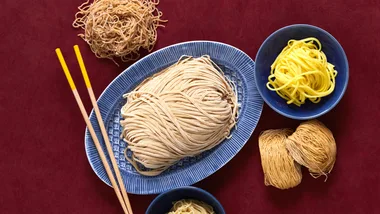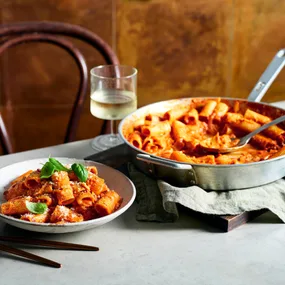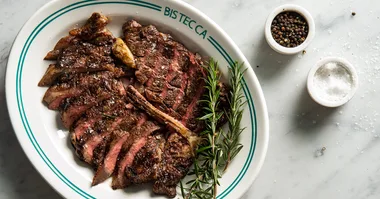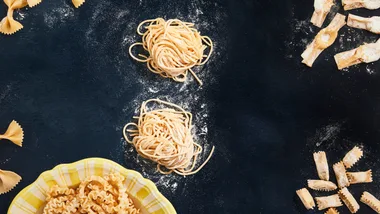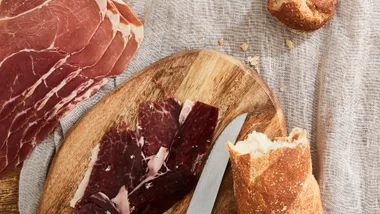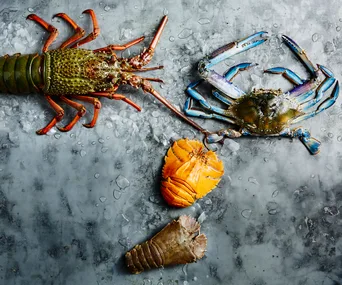Top tips for picking hams from a professional fleischmeister, plus the winners of best ham as awarded by Australian Pork.
Horst Schurger says that the best way to find a good ham is to start with a good butcher. “If he takes care of the meat, chances are he’ll take care of the ham, too.”
We spoke to the German-born fleischmeister and master butcher as he was judging the National PorkMark Ham Awards for Excellence in Sydney with a view to picking up some tips on what makes a good ham.
When you’re tasting, he says, you’re looking for a balanced cure, a natural meaty texture (wet or rubbery is a big no-no) and a good smoky flavour. If you have to choose without first tasting the ham (a practice no fleischmeister would condone), look for smooth, even skin and an even colouring. “And if the knuckle is sunken, it’s overcooked, which means the whole ham is overcooked.”

Barossa Fine Foods’ ham on the bone, served at Sydney restaurant 4Fourteen.
A buckled or uneven rind is another sign of dryness and if there’s a cut ham on display, look for smooth, well-bound meat with no bubbles (they result from fermentation, an indicator of an inferior cure).
Size and age matter, too. Older pigs make for tougher eating, and younger pigs have less flavour, making hams around the 10kg-12kg mark the sweet spot.
The take-home message? Find a good butcher and don’t be afraid to ask questions: whether you can taste the ham, where it comes from, the sex of the animal it was cut from (female is best), and what kind of wood was used to smoke it.
And finally, for the best possible results, opt for fresh Australian pork. Boneless hams can be made in Australia using imported frozen meat; make sure the ham you buy has been made with Australian meat (look for the pink “Australian Pork” label for your guarantee). “It supports the Australian farmers,” says Schurger, “and, of course, it’s better quality.”
THE BEST AUSTRALIAN HAMS IN 2017
On 27 November, Australian Pork announced the winners of its annual PorkMark Ham Awards, as judged by Schurger and chefs Paul McDonald and Simon Bestley.
The key to an award-winning ham, according to Schurger, is balance.
“The flavour must be very well blended. You should not be able to tell the dominant flavour,” he says. “Same with the texture: it shouldn’t be overmassaged or overprocessed. You don’t want to feel like you’re eating porridge or custard.”
After tasting 140 hams over two days, these were the judges’ top picks.
Overall winner and best artisan ham
Pingelly Quality Meats, Pingelly, WA
Australia’s best boneless ham
Pingelly Quality Meats, Pingelly, WA
Runners-up:
Sunvalley Fine Foods, Warana, QLD
German Butchery, Mona Vale, NSW
Australia’s best bone-in ham
Barossa Fine Foods, Edinburgh North, SA
Runners-up:
Noosa Meat Centre, Noosaville, QLD
Lago and Paramount Smallgoods, Melbourne, VIC
HOW TO CARVE A WHOLE LEG HAM
Step 1 Place ham skin side up on a cutting board. Then run a small sharp knife under the rind around the end opposite to the hock and each side of the ham to about halfway up. Peel back the rind.
Step 2 Run the tip of your knife around the bone, on the underside of the ham and begin to slice on a slight angle down towards the bone.
Step 3 Run your knife lengthways along the bone to remove slices. Continue to slice towards the hock.
Step 4 Slice your way around the ham until you reach about a third of the way up then remove the bone by making a few short cuts at the joint.
Step 5 To keep your ham fresh, fold the rind back over the exposed meat, put it in a ham bag or pillowcase, or wrap it in a tea towel and store it in the fridge.
Storing your ham
• Soak a ham bag, pillowcase or tea towel in four cups of water and two tablespoons of vinegar.
• Wring out excess water and put your ham in the bag or pillowcase, or wrap it in a tea towel. Store it in the coolest part of the fridge – ideally below 4C.
• Every three days or so when it starts to dry out, rinse the bag or tea towel and dip it in the water and vinegar solution.
To see the National PorkMark Ham Awards for Excellence winners and for more information, visit australianpork.com.au.
 Ben Dearnley (main), Don Arnold(4Fourteen ham)
Ben Dearnley (main), Don Arnold(4Fourteen ham)

